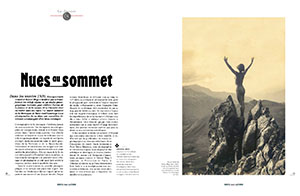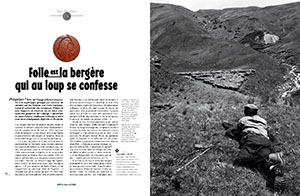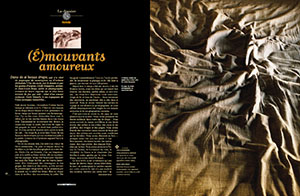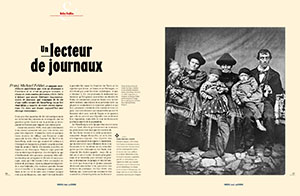Translations: Cary Bartsch
Written for people looking for information with meaning, L’Alpe is the first review devoted to the many cultures and heritages of Alpine Europe. Its ambition is to provide information, language barriers not withstanding. As your guide, L’Alpe looks at the people who, from the meandering Danube to the Rhône, have adapted to an exceptional climate. A cross between a book and a magazine, it draws on the first to provide background documents on a main theme, supported by rigorous analysis, an insistence on quality and the notoriety of renown authors. From the second, it adopts a quarterly rhythm for regular contributions to current debates, rich illustrations, the insatiable curiosity of its journalists and a necessarily didactic approach. Though rigorous in its approach to knowledge, L’Alpe is not a scientific journal. It calls on the contributions of history, geography, archaeology, ethnology, etc. to shed light on the meaning of the traces left by man on the mountain environment. And it is also open to current debates on the future of the Alps and other mountains in the world.
Introductory guide to Alpine gaudriole
On contemplating the arts (literature, painting, photography, cinema), one notices that the Alps have produced very few erotic works. As if the mountains were the centre of all fantasies, as if they alone could be desired. Do people make love differently in the mountains? Antoine de Baecque sweeps us off our feet in a carousel of desire.
 Naked summits
Naked summits
In the 1920s, Georges-Louis Arlaud and Marcel Meys had no qualms about transforming the Alpine summits into an intimate photographic studio to celebrate the bonds between women and nature. Is Utopia perhaps to be found in the Alps? The National mountain museum in Turin pays tribute to the nu photographs in a travelling exhibition with a handsome catalogue.
The surprising farandole of Alpine ephebes
Among other extravagant features of the Monte Verità region is the Sanctuarium Artis Elisarion. Built in 1927 in Minusio (near Locarno, in the Tessin canton, Switzerland) by philosopher Eduard von Mayer, the centre housed, in a secondary building, a stupendous, circular painting covering the entire inside wall of a rotunda (measuring 3.5 x 26 metres), titled The clear world of the blissful (by Elisàr von Kupffer).
 When shepherdesses kneel before wolves
When shepherdesses kneel before wolves
Priapic? That is the cliché drawn from Greek mythology that continues to characterise shepherds to this day. The Greeks always presented Priapus, the shepherd, with an erection. But what actually goes on up in the high pastures? Guillaume Lebaudy, an expert in pastoralism, has collected accounts, legends and songs.
Eroticism and landscapes
Women progressively occupied the central role in Swiss tourism posters. Between 1900 and 1930, ski resorts discovered an effective means, deemed acceptable in some places, scandalous in others, to promote Alpine tourism. The result was a new iconographic style in which the feminine body was liberated, eroticised and even transformed into a seductive landscape.
 Portfolio
Portfolio
Touching lovers
In sheets such as these, who has not dreamed of mountain summits and furious oceans? Using words, drawings and light, Cécile Beaupère, artist, and Jean-Louis Roux, writer and photographer, mingle their perceptions of the most enduring story, that of budding love. Carte blanche to these (almost) immobile Alpine travellers…
Exhibition
Resource or inspiration?
Mountain design, the two words together are not an oxymoron, far from it. More and more designers now draw their inspiration from mountains. Both for the shapes of objects and the choice of materials. The challenge is to blend contemporary and traditional styling, using the Alpine ciphers and symbols.
 Good reading
Good reading
A newspaper reader
Franz Michael Felder, a self-taught farmer in Austria, that nothing destined to become a writer beyond his own desire, succeeded in just three short decades (1839 to 1869) in producing a strikingly perceptive set of literary works on life in a remote valley of the Vorarlberg. A place where reading was (already) a curious activity. To say nothing of writing. A text that resonates surprisingly well with our own times…
Exhibition
In praise of diversity
Geneva is very patient when it comes to museums. For the past 17 years, the Art & History museum has attempted to overcome « popular » efforts to halt the project of architect Jean Nouvel. In the meantime, the Ethnographic museum recently opened to the public, after some 15 years of delays (and changes in the project) in the country of direct democracy. A guided visit.


